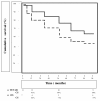Outcome of open and endovascular repair in acute type B aortic dissection: a retrospective and observational study
- PMID: 20380711
- PMCID: PMC2856556
- DOI: 10.1186/1749-8090-5-23
Outcome of open and endovascular repair in acute type B aortic dissection: a retrospective and observational study
Abstract
Background: The aim of the study was to analyze surgical and endovascular results in the treatment of acute type B aortic dissection (B AAD).
Methods: Retrospective and observational analysis with patient inclusion between January 2001-December 2008 and follow-up ranged from 2 to 96 months (median = 47.2) was performed. Out of 51 consecutive patients with B AAD, 11 (21.6%) had to undergo open surgery (OS) and 13 (25.5%) endovascular treatment (TEVAR).
Results: There was a significantly difference in early mortality in the TEVAR group (0/13,0%) vs OS group (4/11,36.4%, P < 0.05) and in the incidence of paraplegia/paraparesis (OS 2,28.6% vs TEVAR 1,7.7%, P < 0.05), renal failure (OS 3, 42.8% vs TEVAR 1, 7.7%, P < 0.05), respiratory failure (OS 2,28.6% vs TEVAR 1,7.7%, P < 0.05) and cerebrovascular accident (OS 1,14.3% vs TEVAR 0,0%, P < 0.05). The late mortality at a follow-up was 30.8% (4/13) in the TEVAR group and 42.8% (3/7) in the OS group, respectively (P = not significant). The cumulative survival rate after 1, 3 and 8 years was 93%, 84%, and 69% in the TEVAR group and 86%, 71% and 57% in the OS group, respectively. Endoleaks were diagnosed in 2/13 endovascular patients (15.4%).
Conclusions: TEVAR group had a significantly reduction in early mortality and postoperative complications. No significant differences were found in terms of cumulative survival at follow-up. On this basis TEVAR could be considered an option in the treatment of these complex cases with all proper reservation especially related to the small sample sizes examined.
Figures
References
-
- Marui A, Mochizuki T, Mitsui N, Koyama T, Kimura F, Horibe M. Toward the best treatment for uncomplicated patients with type B acute aortic dissection: a consideration for sound surgical indication. Circulation. 1999;100:275–80. - PubMed
-
- Miller DC, Mitchell RS, Oyer PE, Stinson EB, Jamieson SW, Shumway NE. Independent determinants of operative mortality for patients with aortic dissections. Circulation. 1984;70:153–640. - PubMed
MeSH terms
Substances
LinkOut - more resources
Full Text Sources
Other Literature Sources


